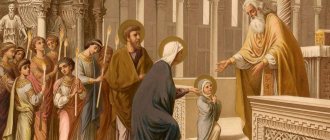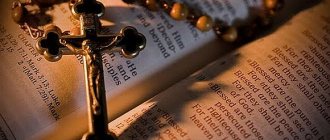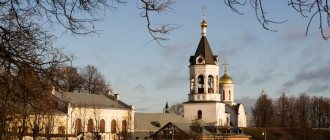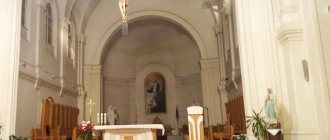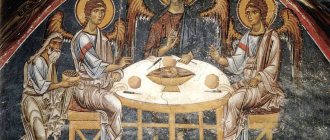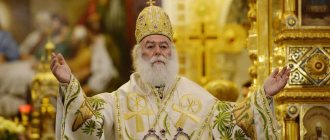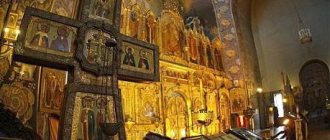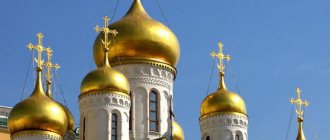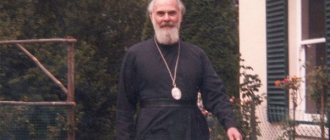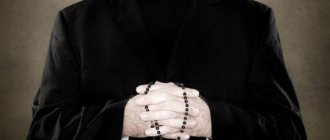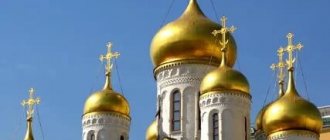ORTHODOX CHURCH IN AMERICA
ORTHODOX CHURCH IN AMERICA (OCA; English Orthodox Church in America), one of the autocephalous Orthodox local churches. Kanonich. territory - USA and Canada, the jurisdiction of the OCA also extends to some parishes in Mexico.
The foundation of the OCA was laid by the missionary monks of the Valaam Monastery, who arrived in 1794 on the island. Kodiak according to the definition of the Synod of Rus. church about the appointment of an Orthodox mission to Alaska. Among the missionaries was St. Herman of Alaska. In 1840 the Kamchatka, Kuril and Aleutian diocese of Rus was established. church, the first bishop of which was St. Innokenty (Popov-Veniaminov). In 1898–1907, the Orthodox flock in America was cared for by St. Tikhon (Belavin), later Patriarch of Moscow and All Rus'; under him (in 1905) the diocesan center was moved to New York, and from 1907 the diocese began to be officially called Rus. Orthodox Greek Catholic church in North America under the jurisdiction of the hierarchy of the Russian Church. Rus. The church in America united all Americans. Orthodox, regardless of their nationality. belonging, which was recognized as legal by all local churches.
With the beginning of the 1st World War and subsequent revolutions. events in Russia connection North-Amer. the diocese and the Church in the homeland were disrupted. In 1921 in America, without the knowledge and canon. With the consent of the Russian Orthodox Church, the Greek Church was established. archdiocese; later other ethnic groups appeared. Orthodox jurisdictions. In 1924, the Cathedral of North America. diocese, contrary to the canons, proclaimed the temporary autonomy of Rus. churches in North America (North American Metropolitan District, North American Metropolis) under the control of. Metropolitan Plato (Rozhdestvensky), in 1937 full autonomy was proclaimed, which was not recognized by the Russian Orthodox Church. In the post-war period, the process of rapprochement between North America began. metropolis from Moscow. patriarchy, official negotiations on the restoration of canonical relations began in 1969. At the request of the Council of North America. metropolis 10.4.1970 The Synod of the Russian Orthodox Church decided to grant the metropolis autocephaly; The autocephalous OCA was formed. This decision of the Russian Orthodox Church came into conflict with the vision of the future of Orthodoxy in the North. America, divided by the Patriarchate of Constantinople. To the beginning 21st century most local Orthodox churches, including the Patriarchate of Constantinople, have not officially recognized the autocephaly of the OCA, although they do not dispute the canonicity of its episcopate and clergy.
In the beginning. 21st century The OCA numbered up to 1 million believers (according to the OCA; independent researchers estimate from 85 to 115 thousand believers in the USA), 14 dioceses (11 territorial, 3 ethnic), 17 monasteries, 3 theological seminaries. Higher adm. and legislator. power in the OCA belongs to the All-American Council; The Holy Synod, consisting of all ruling bishops, is the highest canonical body. and the judiciary. The Primate of the OCA is the Archbishop of Washington, Metropolitan of All America and Canada, and presides over all collegial bodies of the highest church government. From the beginning 1990s The OCA has a courtyard in Moscow at the VMC Church. Catherine on Vspolye.
Orthodox Saints of America
Briefly about the history of Orthodoxy in America
The penetration of Orthodoxy into North America began from its western tip - the Alaska Peninsula and the adjacent Aleutian Islands, where, when these lands were under the hand of the Russian emperors, Russian missionaries worked hard to educate the local residents.
Later, in the 19th-20th centuries, emigrants from Serbia, Syria, Greece, Romania, Bulgaria and other countries with a high proportion of Orthodox populations began to arrive in the “mainland” United States, and their pastors also followed them.
Finally, the 20th century, with its revolutionary upheavals, again brought to America a huge number of emigrants from Russia, including clergy, who were able to organize their own theological schools in the United States and convey interest in Orthodoxy to local residents.
Thanks to this, at present a unique situation has developed in the USA and Canada, when on the territory of the country there are significant church communities of the ROCOR, the Serbian Church, the Antiochian Patriarchate, the Romanian Church, the Bulgarian Church and other Churches, as well as the youngest of the 15 Local Orthodox Churches, which we know as the Orthodox Church in America.
Saints of America
Over the centuries of mission and spiritual life on the North American continent, several ascetics of piety, glorified by the Church, have shone here with their holy lives. Today we will briefly tell you about their life.
Saint Mardarius of Libertville
Today, Saint Mardari (Uskokovic), canonized by the Serbian Orthodox Church in 2015, is the last in the chronological sequence of the American saints glorified by the Church (December 12).
Ivan Uskokovic was born near the city of Podgorica in Montenegro in 1889 into a deeply religious family, and as a teenager was sent by his parents to study in Rijeka and then in Belgrade.
In Belgrade, young Ivan decided to devote his life to serving God and in 1909 became a monk at the Studenica Monastery, then was ordained a deacon and sent to serve and receive education in Russia.
The future hierarch studied at the Volyn and Chisinau seminaries and the St. Petersburg Academy, from which he graduated with a candidate of theology, and in 1917 he was sent to serve in the USA as the head of the Serbian spiritual mission.
In 1923, Father Mardari purchased about ten acres of land in Libertyville, Illinois, where a monastery was later built in honor of St. Sava of Serbia. This monastery became the first Serbian monastery in the USA.
In 1925, the Council of the Serbian Church elected Archimandrite Mardarius as bishop and in 1926, on the feast of the Entry of the Lord into Jerusalem in the cathedral church of Belgrade, he was consecrated as a bishop, and in 1927 he returned to the USA.
Since then, His Eminence Bishop Mardari has worked tirelessly in the construction of churches, the monastery of St. Sava in Libertyville, and also conducted extensive missionary work in the diocese he headed.
Bishop Mardari reposed peacefully in the Lord in 1935, after ten years of ruling his see. The body of the saint of God was buried in the church of the monastery he founded in the USA.
The Council of Bishops of the Serbian Orthodox Church, at the proposal of the Council of Bishops of the SOC in North and South America, at its regular meeting on May 29, 2015, glorified Bishop Mardari as a saint.
The canonization took place on September 5, 2015 in the Stephen Cathedral in Alhambra (California), which was performed by Serbian Patriarch Irinej. During the same service, Bishop Sebastian (Dabovich) was also canonized.
Hieromartyr Juvenal of Alaska
Yakov Govorukhin, who later became Hieromonk Juvenaly, was the first ascetic to achieve holiness on the North American continent.
The Alaskan martyr was born in the city of Yekaterinburg in 1761 into the family of a worker in one of the Ural factories. In 1791, Yakov went to the Valaam Monastery, where he soon accepted monasticism and holy orders.
In 1793, missionary monks from Valaam went to Russian America. Hieromonk Yuvenaly also went with them. In two months, educators traveled in kayaks around the entire island of Kodiak (Alaska), baptizing the entire population and instructing young people in faith and crafts.
In 1795, Father Yuvenaly traveled to Nuchen, where he led more than seven hundred Chugach to Orthodoxy, and in 1796 he arrived in Alaska. In total, the missionaries baptized 6,740 Aleuts and performed 1,573 weddings.
Saint Juvenal ended his life as a martyr. However, there are several versions of his death. It was long believed that the missionary was killed near Lake Iliamna in Alaska, and he was tortured by local shamans, dissatisfied with the successful missionary work.
The second version says that Hieromonk Juvenaly was killed near the aforementioned lake by the Yupik tribe, but later they converted to Orthodoxy.
According to the third version, based on the report of Archpriest Mikhail Oleksa, Father Juvenaly died at the hands of Eskimo hunters 200 kilometers west of Lake Iliamna. The saint's relics were never found.
In 1980, the saint was canonized by the Russian Orthodox Church as a hieromartyr. Saint Juvenal of Alaska is commemorated on May 2.
Righteous Alexy Tovt
The future saint was born into the family of a Uniate clergyman near Presov (Slovakia) in 1854 and over time also accepted holy orders.
Father was very educated, as he managed to study at Catholic and Uniate seminaries and at the University of Presevo, and also mastered several languages. Thanks to his education, he took the position of secretary under the Bishop of Prešov, began teaching at the seminary and managing a local orphanage.
In 1889, Father Alexy arrived in Minneapolis, where he headed the Uniate parish. In 1890, thanks to Bishop Vladimir (Sokolovsky) of the Aleutians and Alaska, Father Alexy, as well as 8 of the 10 remaining American Uniate priests and 361 laymen gathered in the city of Wilkesbarre and converted to Orthodoxy.
After reunification with the Church, Father Alexy was appointed dean with the task of also caring for the communities of Chicago. During these years, for his own food, the saint began to work in a bakery, and distributed a significant part of the money he earned to the poor and needy, among whom were priests with many children.
Father Alexy began preaching among emigrants with Slavic roots. Communicating with Roman Catholics, Greek Catholics and Protestants, he always emphasized that true salvation can only be found in Orthodoxy.
Over the more than ten-year period of his preaching ministry, the righteous protopresbyter managed to bring 17 Greek Catholic parishes and about 29,000 Uniates into the fold of the Orthodox Church. For his missionary work he was sometimes called the “father of American Orthodoxy.”
Father reposed in the Lord in 1909, and in 1994 the Orthodox Church in America glorified him as a saint. The relics of the saint rest in the Church of St. Tikhon of Zadonsk in the Tikhon Monastery in South Canaan (Pennsylvania).
Reverend Sebastian of Jackson
On July 9, 1863, a boy was born into a family of Orthodox emigrants from Serbia who lived in San Francisco. At a young age, in 1884, Jovan Dabovich entered the theological academy in St. Petersburg, and four years later he took monastic vows with the name Sebastian and the rank of deacon.
Having completed his education, Father Sebastian returned to the USA, where he began to serve in the San Francisco Church of St. Alexander Nevsky. In 1892 he was ordained a priest and became a missionary on the West Coast of the United States.
Hieromonk Sebastian founded several churches in Washington and California, then worked in the administration of the North American mission under the leadership of Saint Bishop Tikhon (Belavin), the future Patriarch of Moscow and All Rus', preaching in English, Serbian and Russian.
During his life, the missionary crossed the Atlantic Ocean 15 times and the Pacific Ocean 9 times, as he had to visit his historical homeland - Serbia, Russia, and also make missionary trips to Japan, where the monk met with St. Nicholas of Japan (Kasatkin).
In 1905, already in the rank of abbot, Father Sebastian was appointed to the position of dean of Serbian churches, and in the same year, by decree of the Synod, he was appointed head of the Serbian mission. For his work for the benefit of the Church in 1905, he was elevated to the rank of archimandrite.
In 1910, Father Sevastian went to Serbia, where he served as a chaplain during the Second Balkan (1912-1913) and First World War (1914-1918) and from 1936 began to live in the monastery of St. Sava the Serbian in Žić.
In 1940, Saint Sebastian reposed in the Lord. His funeral service was performed by Saint Nicholas of Serbia (Velimirović). In 2007, the saint’s relics were reburied in the Church of St. Sava in Jackson (California), which was founded by the Monk Sebastian.
On September 4, 2015, in the Stephen Cathedral of the Californian city of Alhambra, Patriarch of Serbia Irinej led a service at which Archimandrite Sebastian (Dabovich) was glorified as a saint as the Venerable Sebastian of Jackson.
Martyr Peter Aleut
Chuganak (baptized Peter) was an Aleut, Alaskan Indian or Creole and was born at the end of the 18th century. Almost nothing is known about his life, except that the young man was baptized by St. Herman of Alaska.
In 1812, the Russian colony of Fort Ross was founded near San Francisco in California by the Russian-American Trading Company. Peter and other company employees were engaged in fishing for seals and other marine animals in these places.
In 1815, a group of 14 Aleuts, including Peter, worked on the shore near San Pedro Bay. Here they were attacked by armed horsemen from among the Spanish military. Spanish monks tried to convert the captured Russians to Catholicism, but they showed their pectoral crosses, declaring that they had already been baptized into Orthodoxy.
Then they decided to torture the captured. They began to cut off the joints on Peter's toes, then on his arms, then on his feet and hands. As a result, the martyr died from loss of blood, but did not change his faith. The rest of the company's employees, who witnessed his feat, managed to escape.
The glorification of the martyr Peter Aleut was performed by the Orthodox Church in America in 1980. In honor of the martyr Peter, several churches were built on the North American continent. The saint is commemorated on September 24.
Other American Saints
We have looked at the brief lives of only five American saints, but in reality there are many more.
On the territory of North America, the following shone: righteous Jacob (Netsvetov), saint and wonderworker John of Shanghai, Venerable Herman of Alaska, Saint Raphael of Brooklyn, Saint Innocent (Veniaminov), Saint Tikhon (Belavin), hieromartyr John Kochurov and hieromartyr Alexander Khotovitsky. You can read their brief lives on the website of the Eastern American Diocese of the ROCOR.
Also associated with the United States of America are the lives of St. Nicholas of Serbia, St. Brendan the Navigator, Hieromartyr Seraphim (Samoilovich), Hieroconfessor Barnabas (Nastich), Hieromartyr Anatoly (Kamensky) and Hieromartyr Vasily Martysh.
Andrey Szegeda
You can applaud the author (at least 10 times)41
History of American religion
Before the arrival of Europeans, the territory of the modern United States was inhabited by tribes of Indians, most of whom believed in the existence of a higher being, the creator of the world. For some it is the son of Heaven and Earth, for others it is the Supreme Spirit or a caring woman.
Different tribes attributed different character traits and abilities to the creator. As a rule, this deity lived above the earth, could take on various forms and appearances and was considered one of the many gods who inhabited the earth. Each tribe had its own picture of the world and myths about its creation. Totems were also popular among the indigenous people, which is confirmed in drawings and embroidery.
Christianity comes to the continent during the discovery of America, from the 15th century. The first conquerors and settlers were the Spaniards and Portuguese, who brought the tenets of the Roman Catholic Church here. Protestantism has been widespread in the Americas since the 16th century, during the height of the Reformation in Europe.
Pilgrims from England, Scotland, Holland and France poured into the New World, who wanted to escape both the oppression of the masters and the Catholic dominance, and longed for freedom and independence. This influenced the formation of a new nation and state, which absorbed the foundations of Protestant ethics and the idea of pluralism in religion.
Most widespread religion in the USA
Statistics show that the Protestant movement is the most popular among Americans. This is because worshipers periodically adapt religion in a new way.
Here are modern texts and a vision of the picture of life. She is not fixated on old traditions, but at the same time she does not destroy them, but only rethinks them. Although such a huge number of immigrants come to America every year, the answer to this question may change in a few years. Because every religion does its maximum to preserve its culture.
Reasons for coming to an Orthodox church
Photo: Picsy.ru
In Russia, an Orthodox church is an integral part of the landscape. And people come there for the same reason that their ancestors came - to pray, light candles, perform the Sacraments. They perceive the Church as an obligatory part of their life. It is unshakable, unchangeable, it was, is and will be. This, according to Russian people, is its strength and attractiveness for people. If people feel good, they will light thanksgiving candles; if they feel bad, they will kneel down and ask the Lord, the Mother of God and all his saints for help and support. For all this, people go to church.
But in America, an Orthodox church is something new. At first they enter it out of curiosity. Then they begin to study the basics of Orthodoxy. They understand God’s Commandments and can no longer leave there.
After all, most people understand that the notorious tolerance and perverted attitude towards issues of sex and marriage is unnatural. It’s even biologically unnatural, not to mention the moral side of the issue. But the loyalty to these things imposed at the state level forces people to accept the generally accepted attitude. Constantly touching dirt leaves people feeling unclean and disgusted with themselves.
In Orthodoxy, issues of sex and marriage are described clearly and clearly, and for many centuries this attitude is unambiguous and unchanged. Dirt here is called dirt, lust is lust, fornication is fornication. And no tolerance. Only purity elevated to the rank of God's Law.
This is precisely what attracts Americans in the first place – clear, natural and strict moral rules. They see the differences, they understand what the truth is.
Adventist Doctrine
- The second coming of Jesus Christ is indicated by 5 signs: the decline of morality, the existence of the papacy, the increasing fear of people about future events, the emergence of Adventism, open preaching throughout the world.
- Along with the Bible, Seventh-day Adventists also study the Prophecies of Ellen White. Almost all doctrines of the Adventist Church are based on this “divine revelation.”
- The main point of teaching is the honoring of the Sabbath. It arose based on the vision of Ellen White, in which she saw all the Divine commandments burning with bright fire, except for one, which calls for honoring the Sabbath. Based on this, Adventists concluded that all other religious movements have apostatized from the Lord, violating this commandment, and therefore cannot be accepted into the Kingdom of God. Only Seventh-day Adventists can be saved.
- Speaking of the soul, Adventists believe that it is mortal until the Lord resurrects it. They also deny the fact that a person can go to hell for his sins.
Over time, Seventh-day Adventist teachings became more Protestant-like. And even Ellen White's authority began to be questioned.
Mormons
Mormons are members of the Church of Jesus Christ of the last days. This religious movement is very controversial. Rather, it is more like an occult sect in which the Christian-Biblical principle is manifested only externally.
The main center of Mormons is located in Utah. Their main mission is to help people achieve the Divine Kingdom. Its implementation falls on the shoulders of the organizational structure created under the Church. The core of the entire Mormon church is the congregation, which should consist of no more than 500 people. In each of them, missionary activities are carried out on the ground. As soon as the number of people in one parish exceeds the allowable limit, it is divided in half. The parish is headed by the president and his two advisers. The number of parishes in one region is also limited. If there are a lot of them in a certain territory, then a special organization is created - a “stake”, which is also headed by the president.
Seventh-day Adventists
This Protestant movement preaches that Jesus Christ will soon descend to Earth again. At first glance, it may seem that this movement is no different from the Protestant one. However, several key features of Adventist teaching do not allow us to call them Protestants. Seventh-day Adventists can rather be classified as a quasi-denomination.
Mormon ordinances
Mormon scriptures include the Bible, the Book of Mormon, the Covenants and Doctrines, and the Pearl of Great Price.
Mormons do not have a canonized prayer. Rather, it is like an improvisational trust in the Lord. A special place is occupied by the rite of baptism, which consists of being immersed in water three times and pronouncing certain words, called the triune formula. Anyone who, for any reason, leaves the Mormon Church subsequently has no right to perform this rite. This is the punishment.
Protestantism – plurality and diversity
History says that the New World was populated mainly by those who, due to religious beliefs, could no longer remain in Europe, that is, in the Old World. Basically, these were active, enterprising people who did not agree with the bureaucratization of the traditional Catholic Church of those times - Protestants. They were persecuted by the church authorities, who had enormous power and influence at that time, and therefore they very willingly took part in expeditions overseas, moved to America, and explored new lands. Strictly speaking, America owes its prosperity to them - they were the first.
It is not surprising that the first religious communities were Protestant, and now the main religious movement in America is Protestantism.
